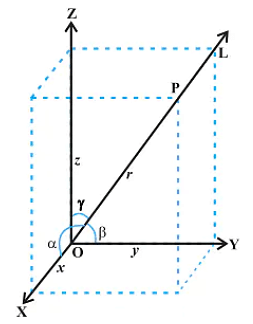If \(θ1,θ2, θ3\) are the angles made by a line with the positive directions of the \(x,y,z\) axes, then the value of \(\cos 2\theta_1 + \cos 2\theta_2 + \cos 2\theta_3\) is
If \(θ1,θ2, θ3\) are the angles made by a line with the positive directions of the \(x,y,z\) axes, then the value of \(\cos 2\theta_1 + \cos 2\theta_2 + \cos 2\theta_3\) is
\(1\)
\(-1\)
\(2\)
\(-2\)
\(0\)
The Correct Option is B
Approach Solution - 1
Given that \(\theta_1, \theta_2,\) and \(\theta_3\) are the angles made by a line with the positive directions of the \(x, y,\) and \(z\) axes, respectively, we know from the property of direction cosines that:
\[ \cos^2 \theta_1 + \cos^2 \theta_2 + \cos^2 \theta_3 = 1 \]
We are asked to find the value of \(\cos 2\theta_1 + \cos 2\theta_2 + \cos 2\theta_3\). Using the double-angle identity for cosine, \(\cos 2\theta = 2\cos^2 \theta - 1\), we can rewrite the expression as:
\[ \cos 2\theta_1 + \cos 2\theta_2 + \cos 2\theta_3 = 2\cos^2 \theta_1 - 1 + 2\cos^2 \theta_2 - 1 + 2\cos^2 \theta_3 - 1 \]
Simplify the expression:
\[ = 2(\cos^2 \theta_1 + \cos^2 \theta_2 + \cos^2 \theta_3) - 3 \]
Substitute the direction cosines property:
\[ = 2(1) - 3 = -1 \]
Thus, the value of \(\cos 2\theta_1 + \cos 2\theta_2 + \cos 2\theta_3\) is \(-1\).
Approach Solution -2
We know that if \( \theta_1, \theta_2, \theta_3 \) are the angles made by a line with the positive directions of the x, y, and z axes, then
\( \cos^2\theta_1 + \cos^2\theta_2 + \cos^2\theta_3 = 1 \)
Also, we know the trigonometric identity \( \cos 2\theta = 2\cos^2\theta - 1 \). Thus,
\( \cos 2\theta_1 = 2\cos^2\theta_1 - 1 \)
\( \cos 2\theta_2 = 2\cos^2\theta_2 - 1 \)
\( \cos 2\theta_3 = 2\cos^2\theta_3 - 1 \)
Adding the three equations, we get
\( \cos 2\theta_1 + \cos 2\theta_2 + \cos 2\theta_3 = 2(\cos^2\theta_1 + \cos^2\theta_2 + \cos^2\theta_3) - 3 \)
Since \( \cos^2\theta_1 + \cos^2\theta_2 + \cos^2\theta_3 = 1 \), we have
\( \cos 2\theta_1 + \cos 2\theta_2 + \cos 2\theta_3 = 2(1) - 3 \)
\( \cos 2\theta_1 + \cos 2\theta_2 + \cos 2\theta_3 = 2 - 3 = -1 \)
Final Answer: The final answer is \(-1\)
Top Questions on Three Dimensional Geometry
- If A(2,1,-1), B(6,-3,2), C(-3,12,4) are the vertices of a triangle ABC and the equation of the plane containing the triangle ABC is $53x+by+cz+d=0$, then $\frac{d}{b+c}=$
- TS EAMCET - 2025
- Mathematics
- Three Dimensional Geometry
- If $(\alpha, \beta, \gamma)$ is the foot of the perpendicular drawn from a point $(-1,2,-1)$ to the line joining the points $(2,-1,1)$ and $(1,1,-2)$, then $\alpha+\beta+\gamma=$
- TS EAMCET - 2025
- Mathematics
- Three Dimensional Geometry
- If m:n is the ratio in which the point $\left(\frac{8}{5}, \frac{1}{5}, \frac{8}{5}\right)$ divides the line segment joining the points (2,p,2) and (p,-2,p) where p is an integer then $\frac{3m+n}{3n}=$
- TS EAMCET - 2025
- Mathematics
- Three Dimensional Geometry
- Let $\pi_1$ be the plane determined by the vectors $\hat{i}+\hat{j}, \hat{i}+\hat{k}$ and $\pi_2$ be the plane determined by the vectors $\hat{j}-\hat{k}, \hat{k}-\hat{i}$. Let $\vec{a}$ be a non-zero vector parallel to the line of intersection of the planes $\pi_1$ and $\pi_2$. If $\vec{b} = \hat{i}+\hat{j}-\hat{k}$ then the angle between the vectors $\vec{a}$ and $\vec{b}$ is
- TS EAMCET - 2025
- Mathematics
- Three Dimensional Geometry
Show that the following lines intersect. Also, find their point of intersection:
Line 1: \[ \frac{x - 1}{2} = \frac{y - 2}{3} = \frac{z - 3}{4} \]
Line 2: \[ \frac{x - 4}{5} = \frac{y - 1}{2} = z \]
- CBSE CLASS XII - 2025
- CBSE Compartment XII - 2025
- Mathematics
- Three Dimensional Geometry
Questions Asked in KEAM exam
- A carbon resistor has a tolerance of 20\%. As per the colour codes of resistors, the last band in that resistor is
- KEAM - 2025
- Resistance
- A body starts from rest and moves with an acceleration of \(2 \, \text{m/s}^2\) and comes to rest with a retardation of \(2 \, \text{m/s}^2\). Find the distance travelled?
- KEAM - 2025
- Current electricity
- Find $ R $ in the following circuit:
- KEAM - 2025
- Current electricity
- Energy dissipated per unit time by a wire of resistance \(2R\) connected to a 2V battery.
- KEAM - 2025
- Current electricity
- A lift having mass 1000kg moves upward against a frictional force of 2000N. Power given by motor is 36000W. What is the velocity of the lift?
- KEAM - 2025
- Speed, Time and Distance
Concepts Used:
Three Dimensional Geometry
Mathematically, Geometry is one of the most important topics. The concepts of Geometry are derived w.r.t. the planes. So, Geometry is divided into three major categories based on its dimensions which are one-dimensional geometry, two-dimensional geometry, and three-dimensional geometry.
Direction Cosines and Direction Ratios of Line:
Consider a line L that is passing through the three-dimensional plane. Now, x,y and z are the axes of the plane and α,β, and γ are the three angles the line makes with these axes. These are commonly known as the direction angles of the plane. So, appropriately, we can say that cosα, cosβ, and cosγ are the direction cosines of the given line L.
